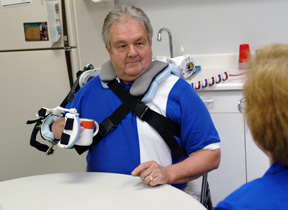
News Releases
|
|
Kimberly Ovitt,
kimberly.ovitt@asu.edu Robotic arm holds promise for stroke survivorsASU researchers and Tempe-based Kinetic Muscles Inc. have developed a robotic arm to help stroke survivors regain the ability to perform basic tasks, such as reaching for objects or feeding themselves.
The research team is led by Jiping He of the Biodesign Institute at ASU. He, who directs the Institute’s Center for Neural Interface Design and is a professor of bioengineering at ASU’s Ira A. Fulton School of Engineering, will present a paper on the design and evaluation of the robotic arm at the ninth International Conference on Rehabilitation Robotics in Chicago June 28 – July 1. Dubbed “RUPERT,” for Robotic Upper Extremity Repetitive Therapy, the prototype is being produced by Kinetic Muscles Inc. for the project, which is funded by the National Institutes of Health. Kinetic Muscles already has a device for hand rehabilitation in stroke survivors on the market. There are two key benefit phases for stroke victims in the project development timetable, He says. The device is able to mimic a fluid, natural extension of the arm using pneumatic muscles and can be programmed for repetitive exercises specific to the user that improve arm and hand flexibility and strength. The team is working to engineer greater intelligence into the device so that it responds directly to a user’s intent. “We want RUPERT to be able to sense when the user is attempting to reach for something, and to automatically assist his volitional movement.” He says. “Not only is the goal to make the motion more intuitive, but we want the robot to assist at those points in the movement where the individual needs it.” As the individual’s motor function improves, RUPERT can adapt to allow the user faster recovery by requiring the muscles to work independently where possible. The first RUPERT prototype was fitted and tested on able-bodied individuals and stroke survivors at Banner Good Samaritan Regional Medical Center in Phoenix. Eight able-bodied individuals tried on RUPERT I to see how well it could be adjusted to fit each person in each case. The testers ranged from 5-foot-tall females to males taller than 6 feet. In addition, two stroke survivors completed a three-week course of therapy using the device. RUPERT II, a second-generation prototype, is under development using results of the fitting evaluations and therapy testing at the medical center. RUPERT I and II are powered by four pneumatic muscles to assist movement at the shoulder, elbow and wrist. The design was based on a kinematics model of the arm, which showed where to locate the pneumatic muscles and how much force was needed for normal reaching and feeding movements. The mechanical arm is adjustable to accommodate different arm lengths and body sizes. Recent research suggests that stroke survivors can recover significant use of their arms by performing repetitive motor function exercises over a period of time. This labor-intensive physical therapy is expensive, however, claiming up to 4 percent of the national health budget, according to the National Institutes of Health. Moreover, health insurers may limit or deny coverage before stroke survivors achieve best results, He says. The availability of a device like RUPERT, which can be used at home with greater frequency and for a longer period of time, may prove to be a more cost-effective approach that could provide better results. Ovitt, with the Biodesign Institute, can be reached at (480) 727-8688 or (kimberly.ovitt@asu.edu).
|

 The rehabilitative device aids in
task-oriented repetitive therapy, and the hope is that it will
provide a cost-effective alternative to traditional therapy. This
would enable a wider population to regain maximum motor
function.
The rehabilitative device aids in
task-oriented repetitive therapy, and the hope is that it will
provide a cost-effective alternative to traditional therapy. This
would enable a wider population to regain maximum motor
function.